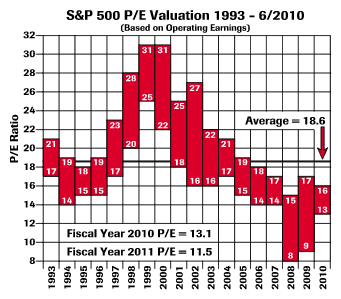2010 Q2 | Headlines, not Fundamentals, Driving Markets
The second quarter was punctuated by two major crises: the European financial crisis and the BP oil disaster. Both dramatically affected the market and both arguably had very little impact on our economy. When we look beyond these two headline-grabbing events, we see a continuation of the economic recovery. This market downturn should prove to be a buying opportunity.
 Due to these events, the stock market had a very volatile second quarter. The quarter started out well as the S&P 500 continued the strong advance of the first quarter with an April increase of 1.61%. Volatility spiked in May as Europe and the Gulf Disaster hit the market. The index gave up 8.06%, taking away all of the year’s gains and then some. June was better but still slightly negative, bringing the quarterly return to –11.45%. It is important to keep in mind that the market experienced an almost uninterrupted 84.3% surge from the March 9, 2009 low to the April 23, 2010 peak. We were due for a correction and the news during the quarter provided the catalyst.
Due to these events, the stock market had a very volatile second quarter. The quarter started out well as the S&P 500 continued the strong advance of the first quarter with an April increase of 1.61%. Volatility spiked in May as Europe and the Gulf Disaster hit the market. The index gave up 8.06%, taking away all of the year’s gains and then some. June was better but still slightly negative, bringing the quarterly return to –11.45%. It is important to keep in mind that the market experienced an almost uninterrupted 84.3% surge from the March 9, 2009 low to the April 23, 2010 peak. We were due for a correction and the news during the quarter provided the catalyst.
The European financial crisis is directly responsible for the excellent performance in bonds during the quarter. The 10-year treasury yielded 3.86% on March 30, and now yields just 2.95% on June 30. We are not reading too much into bond yields as we believe they are artificially low due to the events in Europe.
The European financial crisis has been brewing for some time. A few European economies are experiencing some very difficult economic conditions brought on by profligate spending in years past. Specifically, the troubles in Portugal, Ireland, Greece and Spain raise the possibility that the Euro, established in 1999, may have to be modified. This is the result of European Union members simply ignoring the strict fiscal and monetary standards imposed on them. These serious violations were not followed by enforcement actions, a huge mistake in our opinion. This event has raised uncertainty in worldwide financial markets.
European Union members are supposed to keep their debt-to-GDP level below 60% and their deficit below 3% of their GDP. While it is true more than half of the countries in the EU fail in both categories, we also note that the United States is not particularly well off, either. The U.S. has a “failing” deficit/GDP level by EU standards (11.78%), and has a debt/GDP only a few percent under the limits the EU imposes on its member nations (52.90%).
With this fact in mind, interestingly enough, nervous owners of European sovereign debt are buying the United States’ debt in a “flight to quality.” This has created an uncomfortably low interest rate environment in the United States, as increased demand for U.S. bonds has driven yields to historically low levels. As the European situation improves, we should start to see interest rates move higher again.
We do not think Europe’s troubles will have a significant impact on our economy. On the one hand, the European economies, including the United Kingdom, account for $14 trillion of world GDP, virtually identical in size to the U.S. economy. On the other hand, they account for $228 billion of U.S. exports. This equates to just 1.6% of our economy. Of course, those exports will not disappear entirely, which further dilutes Europe’s impact on our economy.
——————————————————————-
A sovereign debt meltdown could result in a subsequent world-wide credit crisis, which must be averted or we may repeat the events of 2008.
——————————————————————-
These challenges to the European economies, however, have to be successfully addressed. A sovereign debt meltdown could result in a subsequent world-wide credit crisis, which must be averted or we may repeat the events of 2008. In order to fix this problem, the European Union will require substantial emergency measures, just as we did in the U.S. Clearly, they have learned from us about how to deal with a financial crisis. In June, a $1 trillion rescue package was proposed to be funded by the stronger economies of Europe as well as the International Monetary Fund. The funding should be sufficient to stave off the crisis.
The crisis is creating serious problems for investors as income generation becomes very challenging. For the first time in 60 years, companies’ common stock is actually yielding more than their bonds. Investors who need income might consider moving some of their bond money into higher-yielding areas of the stock market. We have developed a custom portfolio expressly for this purpose—the Diversified Income Strategy—which emphasizes income growth along with keeping risk low. Investors incorporating this strategy can expect to generate yields in excess of 4%. Please see our website (www.tuftoncapital.com) for more information, or call your portfolio manager.
This shift makes good sense because our outlook for equities is favorable. In contrast, our short-term view on bonds is unfavorable. Earnings for the first quarter were extremely good, coming in at +32%, well above Wall Street estimates. The consensus expectation for the second quarter, which is to be reported in July and August, appears to be very strong. Corporate balance sheets are quite liquid, with nearly $2 trillion in available cash. We believe that with these significant liquidity balances, corporate capital spending should soon pick up. This should contribute to the economic recovery.

Equity valuations are reasonable, if not downright cheap (see Chart). Price/Earnings multiples for the S&P 500 are very attractively near recent historic lows. Our estimate for S&P 500 earnings for 2011 is between $90 and $95 a share, putting the multiple at less than twelve. This compares to a normal range of approximately 10-20 times earnings. Note that inflation rates impact valuations; the higher the inflation, the lower the price/earnings multiple. We currently forecast an inflation rate of between 1% and 3%, which is at the lower end of the historical range, suggesting that the P/E multiplier for common stocks should be in the top half of the historical range of 10 to 20 times earnings. Clearly, a lot of risk is already priced into the market. Using a multiplier of 14 to 17 and $90/share in S&P earnings implies a price target on the S&P 500 of 1260-1530, substantially above the June 30 close of 1031.
The other crisis facing the economy is the major disaster in the Gulf of Mexico. There is the potential for a very adverse economic development in a region that has been besieged by natural disasters over the last several years. Potentially making the economic impact worse is the government imposed moratorium on new wells in the region. Recently, a judge overturned the moratorium but the Administration has vowed to appeal the decision. Thousands of jobs in the region are affected by drilling, and an extended period without new drilling may have unintended economic consequences. At the present time, the degree of economic impact cannot be determined, but it certainly will not be positive if it continues much longer.
But looking beyond these two crises, the economy continues to expand. When the economy is recovering off a very low level, major sectors send uneven and mixed signals after an initial surge. The economy tends to take a breather before picking up pace again. We seem to be at that stage as we have noticed some softening in the data. On balance, we maintain a positive outlook for the second half of 2010 and for 2011.
In the second quarter, the rate of projected growth should be near the first quarter’s 3%. Housing activity slowed, as expected, because the $8,000 tax credit expired on April 30. But housing has improved significantly from the lows and should continue to benefit from the low interest rate environment. The most important component of the economy, the consumer sector, performed well in recent months. Retail sales, excluding automobile sales, advanced an estimated 8% year over year. Not bad when you consider we still have a very high unemployment rate.
——————————————————————-
The one area of the economy that is not cooperating is employment.
——————————————————————-
The one area of the economy that is not cooperating is employment. As long-time readers of this newsletter know, jobs are the last area to improve. Without question, employment is a lagging indicator. But all of the leading indicators for job creation are very positive. Average weekly hours worked is high. Continuing claims are dropping. Production schedules are ramping up. Corporate profits and cash on the balance sheets are at or near record highs. It is just a matter of time before hiring picks up steam.
Very significant fiscal deficits are projected for the next several years that could have an adverse impact on our economy and the level of inflation several years from now. For the present, we are the reserve currency of the world, and there is no serious threat to that position now that the Euro has come under strain. For the moment, yes, the United States can sin fiscally and financially, but it is unclear how long we can run deficits of greater than 10% of our gross domestic product. This is a critical challenge that must be addressed sooner rather than later. The country must either raise taxes or cut government spending; neither choice is attractive, but is there really an alternative?
On balance, we see good prospects for the economy and equities in the second half of 2010 and into 2011. Interest rates are currently very low, and should move higher with a recovering economy, making bonds less attractive. Such a move would not initially be a negative for stocks because we are coming off of such low interest rates. So, as we enter the second half of 2010, we see an economy in recovery, which is producing very strong profit growth, underpinning current stock market prices.
Our firm continues to add to its bench strength. Steven Shea, formerly executive vice president of Ferris Baker Watts, has joined our firm as Chairman of the Executive Committee and a member of our management team. He brings 20 years of investment banking and banking experience, and he is an important addition to our firm. We feel very fortunate to have him join our ranks.
—Jim Hardesty



